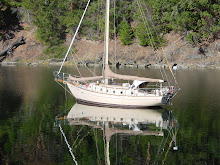La Paz has been an interesting place to visit. Always something happening but we are never sure what it all means.
 Our hotel, the Senorial Montero, has been good to us. The breakfast guy has finally stopped asking for our room number since we have been the only ones eating breakfast for the last week. However, they have a new trick now. In the evening, they do not turn on the lights in the hallway on our floor. We keep forgettng to take a flashlight with us when we go out in the evening so it is a bit of an adventure to find our room. Cost cutting measure I am sure.
Our hotel, the Senorial Montero, has been good to us. The breakfast guy has finally stopped asking for our room number since we have been the only ones eating breakfast for the last week. However, they have a new trick now. In the evening, they do not turn on the lights in the hallway on our floor. We keep forgettng to take a flashlight with us when we go out in the evening so it is a bit of an adventure to find our room. Cost cutting measure I am sure. Downtown is quite different. We walked aways further south (and down) to find that the streets become wider and the whole scene is a bit more upscale with fancy hotels and restaurants. A little rich for us as we now consider that if we pay more than 4 or 5 dollars for a meal, we are getting ripped off!
Downtown is quite different. We walked aways further south (and down) to find that the streets become wider and the whole scene is a bit more upscale with fancy hotels and restaurants. A little rich for us as we now consider that if we pay more than 4 or 5 dollars for a meal, we are getting ripped off!
 Life in the older part of the city, around the Plaza Murillo, is still the most interesting. Some days, for no apparent reason, there will be a huge police presence, with full riot gear, sometimes blocking off several blocks and holding back noisy crowds of people. In all cases they never let these disturbances get within a block of the Plaza and life goes on there as if nothing is happening. We tend to stay clear of such gatherings on general principal.
Life in the older part of the city, around the Plaza Murillo, is still the most interesting. Some days, for no apparent reason, there will be a huge police presence, with full riot gear, sometimes blocking off several blocks and holding back noisy crowds of people. In all cases they never let these disturbances get within a block of the Plaza and life goes on there as if nothing is happening. We tend to stay clear of such gatherings on general principal. Another odd development is the appearance of some ¨traffic zebras¨ at most of the major intersections near the Plaza. Their job seems to be to educate the drivers as to what to do when they are faced with a red light. Seems to work too, except that quite often some official looking person, in some sort of police or army uniform, will show up on one of the corners and start directing traffic, often contradicting the actual traffic lights. Fortunately the drivers ignore them for the most part and after a short while they wander off somewhere else.
Another odd development is the appearance of some ¨traffic zebras¨ at most of the major intersections near the Plaza. Their job seems to be to educate the drivers as to what to do when they are faced with a red light. Seems to work too, except that quite often some official looking person, in some sort of police or army uniform, will show up on one of the corners and start directing traffic, often contradicting the actual traffic lights. Fortunately the drivers ignore them for the most part and after a short while they wander off somewhere else. I have to mention the city center revitalization project which is going on quite near our hotel. Each day we watch as the construction progresses and it is quite enlightening as so much is done by hand. To give them their due, most of the time they do seem to be working quite diligently. Of course, some of the time they look just like any construction project back home. Lots of supervisors and very few workers. We are kind of disappointed that we won´t be able to see the finished project as we have invested considerable time in overseeing the work to this point.
I have to mention the city center revitalization project which is going on quite near our hotel. Each day we watch as the construction progresses and it is quite enlightening as so much is done by hand. To give them their due, most of the time they do seem to be working quite diligently. Of course, some of the time they look just like any construction project back home. Lots of supervisors and very few workers. We are kind of disappointed that we won´t be able to see the finished project as we have invested considerable time in overseeing the work to this point.



































 Day 11
Day 11









